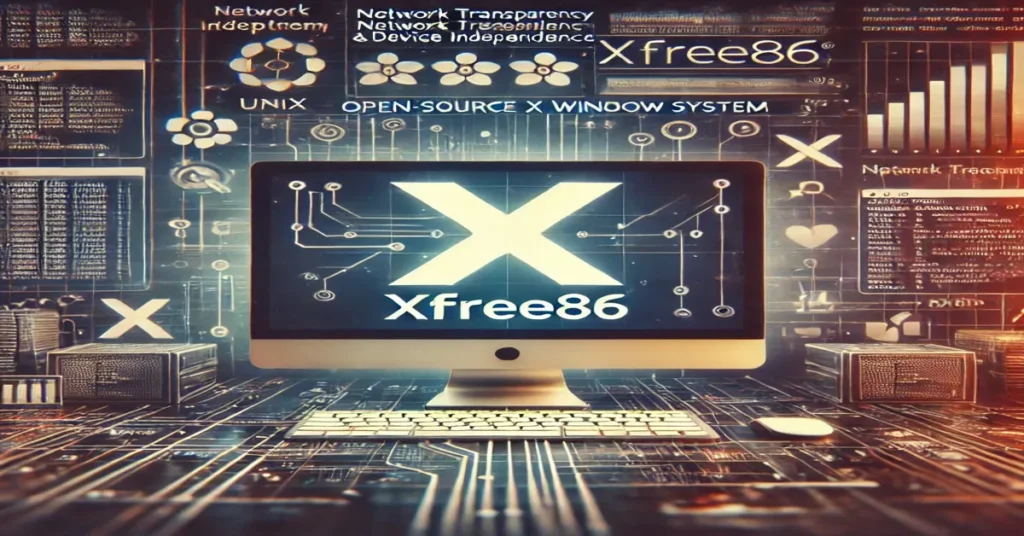In the world of computer science and open-source software, XFree86, commonly referred to as XFree, is an integral part of the history of graphical user interfaces (GUIs) for Unix-like operating systems. XFree is a free and open-source implementation of the X Window System, a framework that allows for the development of GUIs, making it possible for users to interact with their computers in an intuitive, graphical manner.
This article takes a deep dive into the world of X-Free—its origins, contributions to the computing world, the role it has played in the development of user interfaces, and its current standing in the world of software development. Whether you’re a tech enthusiast, a software developer, or simply curious about the history and importance of open-source software, this guide provides an in-depth look at X-Free, its features, and its long-standing legacy.
What is XFree?
XFree, more formally known as XFree86, is a free and open-source implementation of the X Window System. The X Window System, often referred to as simply “X,” is the foundational framework for managing graphical windows on a computer’s display, particularly in Unix-based and Linux operating systems.
X-Free is designed to provide a network-transparent windowing system that allows applications to draw and manage windows on a variety of displays. It enables graphical user interfaces (GUIs) for users, replacing the text-based interfaces of earlier computers with something far more intuitive and user-friendly.
XFree86’s Historical Context
XFree86 traces its roots back to the late 1980s and early 1990s, when there was a strong movement toward creating open-source alternatives to proprietary software systems. The “X” in XFree86 stands for the X Window System, which was initially developed at MIT in the 1980s. The X Window System was designed to create a standardized graphical user interface that would be independent of the hardware and operating system.
XFree86 was created as a free, open-source version of the X Window System specifically tailored for Intel 80386 (i386) systems, which is where the “86” in the name comes from. Over time, X-Free expanded to support a variety of hardware platforms, and it played a major role in making graphical interfaces accessible to Unix and Linux users.
The Core Features of XFree
The XFree86 project aimed to provide a comprehensive and powerful windowing system for Unix-like operating systems. Some of the core features that made X-Free such an influential piece of software include:
- Network Transparency: One of the defining features of the X Window System, including X-Free, is its network transparency. This means that the display of an application does not need to be on the same machine where the application is running. Users can run graphical applications on one computer and display the results on another, over a network.
- Device Independence: XFree is designed to be hardware-agnostic. It abstracts the graphical display away from the specifics of the underlying hardware, meaning that users can run X-Free on a variety of systems and displays without needing hardware-specific software.
- Extensibility: XFree provides a framework for building GUIs but leaves many aspects of the desktop experience, such as window managers and desktop environments, up to the user or system administrator. This allows for significant customization and extensibility.
- Open Source Licensing: X-Free is distributed under a free software license, allowing users to view, modify, and redistribute the source code. This open approach helped foster a large community of developers and users who contributed to the project’s ongoing development.
The Importance of XFree in Open-Source Development
At a time when most graphical interfaces were tightly controlled by proprietary vendors like Microsoft and Apple, X-Free provided an open alternative. Its open-source nature allowed for rapid development and widespread adoption, particularly in the Linux community. XFree’s role in the development of graphical environments on Linux cannot be overstated—without it, the widespread adoption of Linux as a desktop operating system would likely have been much slower.
The Role of XFree in the Development of GUIs
The X Window System, and by extension XFree, was a significant step forward in the development of graphical user interfaces. Before X-Free, most Unix-based systems relied on text-based command-line interfaces (CLIs). These interfaces were powerful but required users to memorize commands and were not particularly intuitive for those new to computing.
Early Graphical User Interfaces
The earliest graphical user interfaces, such as those developed by Xerox PARC, Apple, and Microsoft, were proprietary. These systems were designed for specific hardware and operating systems, which limited their flexibility and user base. However, X-Free helped change that by bringing a GUI to Unix-based operating systems, which had previously been dominated by command-line interactions.
X-Free provided a framework for creating graphical environments that could be customized and extended with new functionality. This was a major innovation, as it allowed for the separation of the underlying operating system from the graphical interface, giving users more control over their computing experience.
XFree and Linux
In the early days of Linux, X-Free was the primary implementation of the X Window System used to provide graphical interfaces. Linux distributions that wanted to offer a graphical environment relied heavily on X-Free to enable desktop environments such as GNOME and KDE.
This made Linux a more accessible platform for general users, who could now interact with their system using windows, icons, and menus instead of the command line. X-Free played a crucial role in expanding Linux’s appeal beyond developers and into the broader computing world, including home users and businesses.
The Decline of XFree and the Rise of X.Org
For many years, XFree was the de facto standard for providing graphical environments on Unix-like systems. However, in the early 2000s, a schism occurred within the X-Free community that led to the creation of a new project called X.Org.
The Licensing Controversy
One of the major reasons for the decline of X-Free was a change in its licensing terms. In 2004, the developers of XFree made changes to the software’s license that introduced a clause requiring more explicit attribution in derivative works. This new licensing requirement was met with backlash from the open-source community, as it was seen as too restrictive compared to other open-source licenses.
As a result, many Linux distributions and other projects began moving away from X-Free and toward a new project called X.Org Server, which was based on X-Free but maintained the more permissive licensing that was standard in the open-source world.
X.Org Server Takes Over
The X.Org Server became the dominant implementation of the X Window System after the X-Free licensing controversy. X.Org is still in use today and continues to provide graphical capabilities for many Linux and Unix-based systems. XFree, meanwhile, saw a sharp decline in usage after the formation of the X.Org Foundation and the subsequent transition of most Linux distributions to X.Org.
Despite this, XFree’s legacy remains important, as it laid the foundation for graphical user interfaces in the open-source world. Many of the innovations introduced by X-Free are still in use today, and the project played a key role in the development of modern Linux desktop environments.
Features and Components of XFree
To fully appreciate the capabilities of X-Free, it’s important to understand its core components and features. Below are some of the primary elements that made X-Free a powerful tool for providing GUIs on Unix-like systems.
1. X Server
The X server is a central component of the X Window System, and XFree86 was designed to implement the X server on a variety of hardware platforms. The X server is responsible for handling input from devices like the keyboard and mouse, managing windows, and communicating with the display hardware.
In X-Free, the X server could run on both local machines (where the user sits) and remote systems, allowing for graphical applications to be displayed across a network.
2. X Client
An X client is any application that communicates with the X server to display a graphical interface. In XFree, applications like terminal emulators, text editors, and web browsers act as X clients. The X server processes their requests to open windows, display graphics, or handle input, and displays them on the user’s screen.
One of the unique features of X-Free is that X clients and the X server do not have to be running on the same machine. Users can run an application on a remote server while viewing its graphical output on their local machine—a feature that was groundbreaking at the time.
3. Window Manager
In X-Free, the window manager is responsible for managing the layout and behavior of windows on the screen. It determines how windows are drawn, resized, minimized, and closed. The window manager is separate from the X server, which allows users to choose from a wide variety of window managers, each offering different features and aesthetics.
Popular window managers used with X-Free include:
- twm (Tab Window Manager): A basic, lightweight window manager.
- FVWM: A highly configurable window manager with support for virtual desktops.
- Enlightenment: A more advanced window manager offering graphical effects and animations.
4. Display Protocols
X-Free uses several protocols to communicate between the X server and the display hardware or network. The most commonly used protocol is X11, which has been the standard protocol for the X Window System since 1987. X11 allows for a wide range of graphical functions, including window management, drawing graphics, and handling input devices.
XFree’s Influence on Modern Graphical Environments
While X-Free is no longer the dominant implementation of the X Window System, its influence is still felt in modern computing. Many of the principles that guided XFree—such as network transparency, device independence, and open
-source development—are still foundational to modern graphical environments.
1. GNOME and KDE
Two of the most popular Linux desktop environments, GNOME and KDE, both owe their existence to XFree and the X Window System. These desktop environments built on the capabilities provided by XFree to create fully-featured graphical interfaces with window management, application launching, and customizable themes.
2. Wayland: A Modern Alternative
As technology has evolved, new alternatives to X have emerged. One of the most notable is Wayland, a modern display server protocol designed to replace X11. Wayland aims to be more efficient and secure than X by simplifying the display server architecture and eliminating some of the overhead associated with X11.
While Wayland is gaining popularity in the Linux community, many systems still rely on X.Org (the successor to XFree) to provide graphical functionality. This demonstrates that, despite the availability of newer technologies, XFree’s legacy continues to shape the way graphical systems are built and used.
3. Remote Desktop and Virtualization
XFree’s support for remote graphical applications has been a key influence on modern remote desktop solutions and virtualization technologies. Today, tools like VNC (Virtual Network Computing) and RDP (Remote Desktop Protocol) allow users to interact with remote graphical desktops, continuing the tradition of network transparency that XFree helped pioneer.
Conclusion
XFree, or XFree86, has been a critical part of the evolution of graphical user interfaces in Unix-like operating systems. From its early days as an open-source implementation of the X Window System to its influence on modern Linux desktop environments, XFree played a pivotal role in making graphical computing accessible to a wider audience.
While XFree is no longer the dominant force in the world of graphical interfaces, its impact is undeniable. The principles of open-source development, network transparency, and hardware abstraction that guided XFree are still important in today’s software development landscape.
As technology continues to advance, newer display systems like Wayland and innovations in desktop environments will carry forward the legacy of XFree, ensuring that the vision of open, customizable graphical computing lives on.
FAQs
- What is XFree? XFree, or XFree86, is a free and open-source implementation of the X Window System, designed to provide graphical user interfaces on Unix-like operating systems.
- What role did XFree play in Linux development? XFree was critical in the early development of Linux desktop environments by providing the graphical framework needed for GUIs like GNOME and KDE.
- Why did XFree decline in popularity? XFree declined due to a licensing controversy in the early 2000s, leading to the creation of X.Org, which became the dominant implementation of the X Window System.
- What is the X Window System? The X Window System is a protocol and software system for creating graphical user interfaces, allowing users to interact with their computer through windows, icons, and graphical applications.
- What are some modern alternatives to XFree? XFree’s successor, X.Org, is the most widely used implementation of the X Window System today. Additionally, Wayland is a newer display server protocol designed to replace X in some environments.
- What are the core features of XFree? Core features of XFree include network transparency, device independence, extensibility, and open-source licensing, allowing for flexible and powerful graphical computing.







